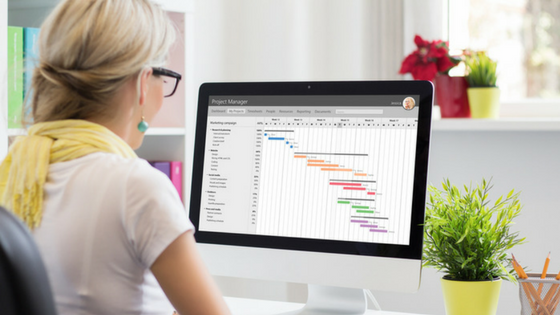I often hear the phrase, “If you can’t measure it, you can’t manage it.” I took the phrase to heart about five years ago and began to focus heavily on measuring the performance of our employees, all of whom telework. I had graphs and scales for everything: How well employees supported company values. How many employees contributed to the company relative to other employees? Hours worked by the employee by task. And so on. My focus on measuring distracted me from the more critical aspects of performance - accountability and transparency.
Don’t get me wrong; I still feel that measurement is essential. But it has to be balanced with the fact that we are human and, as such, many things we do cannot be assigned a value or plotted on a scale. For example, a big part of having a successful remote workforce is promoting trust, which cannot be graphed. Therefore, I now see performance management as more of a process rather than a collection of metrics, especially for remote employees.
Remote Employee Performance Across Industry
I recently came across an attractive website that is remote. co, which presents lessons learned from dozens of companies regarding managing remote workers. Takeaways include:
- Remote employees are often more productive than employees located together in an office. As such, measuring employee output fits nicely into the remote work culture. (Flexjobs, 10up Inc. Beutler Ink, Groove, LoveToKnow, Scapinghub, TeamSnap, Timely, TNTP, Toptal, Tropical Travelers, World Wide Web Hosting, Acceleration Partners, Answer Connect, Blossom, Bright!Tax, Envato)
- It’s not all about measuring productivity. You have to consider whether an employee is thriving and working with passion. Organizational values are used to establish a culture of support and employee growth. (AirTreks, Pagely, Scapinghub, SoftwareMill, Speak, Trello).
- Communication with remote employees is often enhanced through technology, like messaging apps, project management tools, calendaring, and productivity dashboards. Frequent planning calls, daily huddles, and 1-on-1 meetings often augment such technologies. (NodeSource, Mokriya, Project Ricochet, Vork Inc., WooThemes, Big Universe, Inc., Collage.com, Attentiv, Toggl, Batchbook, Project Ricochet, StickerMule, X-Team, Crossover)
- Organizational goals are made clear to all remote employees through techniques like Objectives and Key Results, strategic plans, and balanced scorecards. (Mokriya, PeopleG2, Seeq, Sococo, Taska Technology Solutions, Teleport, TOK.tv, Trade Conductor. Ushahidi, Workform, Authentic Form & Function, Doist, home)
- It is essential to Focus on time management and task priorities to ensure remote employees work according to project management plans and customer expectations. (Sanborn, Simple [A], SitePen, TeamGantt, Tortuga, WorldWide101, Equivity, American Express, DataStax)
- Clear metrics should be established for remote employee performance, taking into account various factors related to each employee’s job (The Cheat Sheet, Universal Mind, Inc., AgileBits, AnswerFirst, Ciao Bambino! Inc., Codebusters, Inc.).
Are Remote Employees Different?
These takeaways are interesting in that most of them also apply to employees who work in an office. I want to tell you that measuring the performance of remote employees is no different than measuring the performance of employees in an office. The significant picture issues are the same: Are employees productive? Are they producing quality work? Do they contribute to the organization? Are they positive team players?
However, there is also a difference between employees working in an office and remote employees, summarized in the first takeaway point. There is a culture surrounding remote work that naturally lends itself to focusing on output. Working remotely requires self-starting employees because they need someone to work with them physically or oversee their efforts directly. That self-starting tendency is often a motivating force that drives remote employees to produce their work quickly and with quality. Combining that tendency with the blocks of uninterrupted time that usually coincide with remote work can yield a highly productive workforce.
However, remote work also comes with a challenge. Remote employees work in isolation, making them feel disconnected from the organization and even undervalued. This is another reason remote employees are often highly productive - they want to feel like they contribute and make a difference since they cannot be seen working physically. Because of this, a performance management system for remote employees, which I outline below, should track performance and encourage engagement and connectivity. A highly productive workforce that is also engaged is awe-inspiring.
Developing a Performance Measurement Process for Remote Employees
The above takeaways can be combined into a process that will significantly enhance the productivity and engagement of remote employees.
Organization Objectives
Performance starts at the organizational level, so I recommend adopting Objectives and Key Results (OKRs). Create and develop three to five objectives for your organization to complete over the next quarter. The objectives can come from your mission statement or organizational values. Examples could include “helping employees thrive and grow” or “increasing company revenue.” Objectives are high-level statements you want all your employees to mobilize around to achieve organizational progress.
Under each objective, there are measurable vital results. Examples include:
- increasing sales by 10%
- 50% of all employees receive training
- purchasing a dozen new laptops
These are just examples, but the important thing is that each key result should be measurable and able to be completed within the quarter.
If you complete all your key results as an organization, you achieve all your objectives for a given quarter. Many theories exist on using OKRs, and this description is admittedly bare-bones. More details can be found within this blog.
Employee Objectives
Now that you have established a set of OKRs for the organization, supporting OKRs should be shown for departments and teams. This process flows down to each employee. In coordination with their manager, employees create their OKRs that support and feed to the OKRs for their team, department, and organization.
Employee OKRs are typically open to view by their manager and other team members, which promotes transparency and accountability. It is important to have OKRs available so everyone can see their role and how it combines with others to fulfill organizational objectives.
So, as employees complete their OKRs, these roll up to the overall organization OKRs. For example, the IT department could write a chapter focusing on technology if an organizational objective is to achieve a strategic plan over the next quarter. The IT security team could draft the security section of that chapter. Individual employees could be responsible for preparing the area, editing, providing images, etc. In this way, the employees' efforts roll up to the organization.
Employee Monitoring
With established OKRs, the next step is monitoring performance. Technology comes in handy here, especially with remote employees. You can use spreadsheets, project management software, etc., but I am a big fan of 15Five. 15Five is an application with a framework for establishing OKRs from the organization to the individual and a reporting feature that enables employees to report progress to their managers weekly.
Regardless of the technology used, having remote employees report weekly is an excellent way to monitor employee and organizational performance. I ask my folks to write their OKR status on Friday at the end of the day, and I review it first thing Monday morning. During my Monday review, I often ask for clarification if I have questions and help refine employee OKRs to ensure they are advancing the company's goals. I have found the weekly effort a pleasing cadence to understand what happened the previous week and plan the week.
Promote Feedback
Communication is vital in engaging remote employees. I recommend two forms of communication to provide performance feedback to employees: regular one-on-one meetings and quarterly performance reviews.
A one-on-one is a routine meeting between a manager and their employees in which the manager focuses on active listening and employee coaching. Typically, one-on-ones should be performed weekly or biweekly and conducted in person. We have found that monthly one-on-ones over video conferences work well for remote teams.
1-on-1s are typically 30 minutes and allow time for:
- Employees to raise issues and ask questions of their manager
- A manager to provide feedback to an employee
- Employees to review upcoming work and ask any questions
- The manager and the employee to focus on the employee’s growth and development in the organization
Quarterly performance reviews are another way to provide feedback on progress. During 1-on-1s, managers mostly listen to employees and help them grow – though any immediate performance issues can and should be addressed. The manager should provide more concrete feedback on an employee’s strengths during quarterly reviews. It wins over the past quarter, areas for improvement, and performance expectations for the employee during the upcoming quarter. Frequent reviews are essential to help remote employees grow and improve performance with regular feedback.
If you have read this far, you may have the same reaction I did when I first heard of 1-on-1s and quarterly reviews: Are you kidding me? Every manager has a different kind of time!
I was squarely in that camp a year ago, but now I have done a 180 – it is our job as managers to ensure that the organization's goals are met and that employees receive feedback to improve performance. Setting aside the time to monitor performance and enhance communications leads to a more engaged workforce and helps the organization achieve its goals more effectively. I ask myself now why I did not think I needed to take the time in the past for 1-on-1s and quarterly reviews. They are transforming us and many other organizations into a performance culture while keeping remote employees engaged and connected.
How the Process Fits Together
In summary, performance measurement for remote employees starts with clearly defined organizational goals. I like quarterly OKRs to establish an organization’s objectives. The next step is for each employee to have individual objectives that tie directly to the organization’s OKRs. These objectives are not a passive list. Employees should report progress to managers weekly. Weekly performance monitoring should be augmented by frequent 1-on-1 meetings between managers and their respective employees to coach and guide the progression of employees. In addition, quarterly performance reviews are designed to provide continual feedback throughout the year. In combination, this process keeps employees engaged and enables the organization to achieve its goals while tracking the performance of all employees.
Remote employees, in particular, benefit from this process because it adds structure and accountability. The system is in a process that clearly defines objectives and keeps employees engaged with the organization. Without it, remote employees can feel more isolated and not understand how their work contributes to the organization. Employees are held accountable for their performance by tracking employee performance every week and having regular 1-on-1s and quarterly reviews. Providing a structure through a process can make up for the need for the physical form of the office setting. Through this structure, the natural tendency of remote workers to be productive is harnessed, significantly benefiting the whole organization.





.jpg)

.png)
.png)
/Employee%20Autonomy%20Part%202%20(Blog%20Title).png)
.jpg)


.jpg)
-1.jpg)
.jpg)
.jpg)
.jpg)
.jpg)
.jpg)
.jpg)

